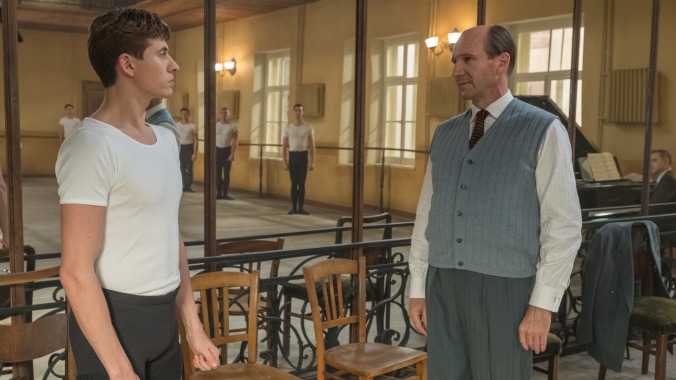From the time he defected from the Soviet Union in 1961 until his health began to visibly decline in the 1980s, Rudolf Nureyev was arguably the most famous ballet dancer in the world—certainly the most famous danseur noble in classical ballet. He was unrefined, intense, a wild child of the dance world. Even in the late 1970s, when Nureyev was clearly past his creative prime as a dancer, he could still move “from pose to pose as if from one living picture to another,” in the words of the astute dance critic Arlene Croce. Or, as Joan Acocella, who succeeded Croce’s esteemed post at The New Yorker, would write some decades later: “Almost everyone who describes Nureyev eventually compares him to an animal. They bore you to death with this, but it was true.” On stage, he oozed sex appeal, drawing inevitable (but misplaced) comparisons to the exotic star of an earlier generation, Vaslav Nijinsky. His partnership with the English ballerina Margot Fonteyn was a phenomenon in the 1960s; his tenure as the artistic director of the Paris Opera Ballet in the 1980s successfully revitalized the world’s oldest ballet company.
Nureyev was also a narcissist, an opportunist, a diva. His tantrums were legendary. By the time he died of AIDS-related complications in 1993, he had left behind enough bad feelings and horror stories to fill several sordidly detailed volumes. He was, in many respects, a biographer’s dream project—an individualist whose life seemed to move in broad and contradictory strokes over a vivid historical canvas that spanned from the tensions of the Cold War at its peak to the glamor of the swinging ’60s and disco ’70s to glasnost and the AIDS crisis. Nureyev was a jet-setter who was literally born on a train; a child of humble origins who grew up to become of the great success stories of Soviet ballet only to leave it all behind; a man who was largely attracted to other men, but had emotionally consuming (and occasionally sexual) relationships with significantly older women.
Ralph Fiennes’ The White Crow, which stars the young Ukrainian dancer Oleg Ivenko as Nureyev, focuses on two key episodes in his life: his years of training at the Vaganova Academy in mid-1950s under the mentorship of the ballet teacher Alexander Ivanovich Pushkin (Fiennes); and the tumultuous 1961 trip to Paris that ended with Nureyev, the sensation of the Kirov Ballet, shouting his plea for political asylum to two plainclothes police officers in the passenger lounge at Le Bourget Airport. One obvious hurdle is that Nureyev, while a fascinating figure, doesn’t exactly fit the definition of a likable protagonist. In The White Crow, we find him spitting at functionaries, glaring at waiters, throwing a childish fit in a toy store while shopping for model trains—generally coming across like a brat entitled by a genius that the movie itself struggles to articulate. (This was also a problem for Fiennes’ last directorial effort, The Invisible Woman, a drama about the relationship between Charles Dickens and his mistress, Nelly Ternan.)
Another problem is that Ivenko isn’t much of an actor—though neither was Nureyev. Despite some passing resemblance between the two, the idea of casting a professional dancer as one of the heavies of 20th century ballet puts the movie in a double bind; Ivenko can’t replicate Nureyev’s magnetism and moves on stage (The White Crow opts to instead mostly show him in rehearsal and practice), and his performance leaves the film without a psychological center. Instead, most of the color comes from supporting characters, played by a capable multilingual cast: Strizhevsky (Aleksey Morozov), the exasperated government minder who has to pull an all-nighter in the lobby of the Kirov Ballet troupe’s Paris hotel every time Nureyev goes out; Clara Saint (Adèle Exarchopoulos), the well-connected socialite who befriends the Soviet dancer while grieving the death of her boyfriend, and somehow puts up with his temper; and especially Pushkin and his ex-ballerina wife, Xenia (Chulpan Khamatova).
The sections of the film that are set in Paris in 1961—covering the eight weeks from Nureyev’s wide-eyed arrival to his climactic defection—feel like an exercise in prolonging the inevitable, unfolding as a repetitious series of nights-on-the-town and trips to the museum. (There’s a third, less significant timeline in David Hare’s script, depicting flashbacks to the dancer’s deprived childhood during World War II; these are shot in outrageously ugly-looking desaturated digital, while the rest of the film is in warm, fuzzy Super 16mm.) But it’s in the mid-1950s sections that The White Crow finds a germ of genuine dramatic tension. Moving into the Pushkins’ claustrophobic, one-room Leningrad apartment to recuperate from an injury that could end his career, the teenage Nureyev begins an affair with Xenia—cuckolding his patient, emotionally reserved mentor while also carrying on a romance with the East German dancer Teja Kremke (Louis Hofmann).
It should be noted that Fiennes—his thinning hair shaved down to a bald pate, his posture belly-out—plays his role entirely in Russian. The crucial syllable accents and emphases of the language are notoriously difficult for non-speakers to fake their way through; the fact that Fiennes’ delivery not only carries notes of lilting dramatic understatement but is entirely intelligible without subtitles is a testament to the actor’s tremendous (and often underappreciated) command of his voice. But the subtleties of the Pushkin scenes are lost on a film that, more often than not, feels tepidly respectable and stiff. Unlike its subject, The White Crow is ultimately forgettable.


